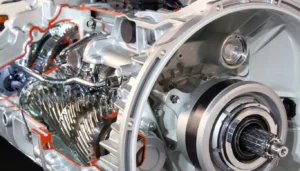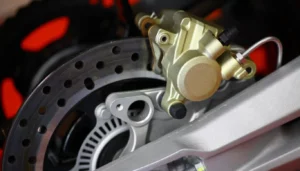Changing a dirt bike tire can be a challenging task, but with the right tools and techniques, it can be done easily. There are several reasons why you might need to change the tire on your dirt bike, including:
Over time, the tread on your dirt bike tire can wear down, making it less effective at gripping the road or the trail. If you notice that the tread on your tire is becoming worn, it’s time to replace it.
If your tire has been punctured, cut, or otherwise damaged, it may need to be replaced to ensure your safety while riding.
Even if you haven’t put a lot of miles on your tires, they will still degrade over time through exposure to the elements. Most manufacturers recommend replacing dirt bike tires every 3-5 years, even if they have not been used very often.
If you’re looking to improve the performance of your dirt bike, you may want to replace the tires with ones that are better suited to your riding style and the conditions you typically ride in.
Changing the tire on your dirt bike is an important part of maintaining your bike’s safety and performance, and can help you enjoy your rides with confidence and peace of mind.
Tools Required to Change The Dirt Bike Tire?
Here are the important tools to change a dirt bike tire:
1. Tire irons:
You will need a set of tire irons or spoons to remove the tire from the rim.
2. Bead breaker tool:
A bead breaker tool is used to loosen the bead of the tire from the rim, making it easier to remove the tire from the rim.
3. Valve stem tool:
You will need a valve stem tool to remove the valve stem core and release any remaining air pressure in the tire.
4. Air compressor:
An air compressor is used to inflate the tire once it is mounted on the rim.
5. Lubricant:
Tire mounting lubricant or soap and water can be used to lubricate the bead of the tire to make it easier to install.
6. Torque wrench:
You will need a torque wrench to properly tighten the axle nut to the manufacturer’s recommended torque specification.
7. Socket set:
A socket set is used to remove the axle nut and other components on the wheel.
8. Cotter pin or axle nut locking clip:
A cotter pin or axle nut locking clip is used to secure the axle nut in place once it is tightened to the correct torque specification.
9. Rim protectors:
If you want to keep the rim in good condition when changing tires, you can apply a rim protector.
Before attempting to change the dirt bike tire, make sure you have all the equipment you need to do it safely and effectively.
Process to Change The Dirt Bike Tire?
It is important to follow these steps carefully and use the appropriate tools to change a dirt bike tire safely and efficiently.
Here is the process to change a dirt bike tire:
1. Remove the wheel
To remove the wheel from your dirt bike, follow these steps:
Place the bike on a level surface and use a bike stand or center stand to keep it upright.
Use a socket wrench or an adjustable wrench to loosen the axle nut on the wheel you want to remove. Do not remove the nut completely yet.
Use pliers or a clip remover tool to remove the cotter pin or axle nut locking clip that holds the axle nut in place.
You have to use a socket wrench or an adjustable wrench to remove the axle nut completely.
Use your hands to slide the axle out of the wheel hub.
Carefully pull the wheel out of the bike’s swingarm.
With the wheel out of the way, you can easily remove the tire or perform any other necessary maintenance.
Remember to follow the manufacturer’s instructions and torque specifications when reinstalling the wheel and axle nut.
2. Deflate the tire
To deflate the tire on your dirt bike, follow these steps:
The valve stem is typically located on the rim of the wheel, and it protrudes from the center of the tire.
Unscrew the small plastic or metal cap on the valve stem to expose the valve core.
Insert the valve stem tool onto the valve stem and turn it counterclockwise to remove the valve core. This will release the air pressure from the tire.
Use your fingers to unscrew the valve core from the valve stem and set it aside.
The tire will begin to deflate as the air escapes through the valve stem. You can speed up the process by gently pressing on the tire to help push the air out.
Use a tire pressure gauge to double-check that there is zero air pressure in the tire after deflation.
Remember to dispose of the valve core in a safe place and keep it away from children and pets.
3. Break the bead
Breaking the bead of the tire means loosening the seal between the tire bead and the rim. Here is how you can break the bead on a dirt bike tire:
Use a center stand or bike lift to lift the bike off the ground and support it in a stable position.
Remove the valve core from the valve stem using a valve stem tool.
Deflate the tire completely by pressing down on the tire with your hands.
Position the wheel on a tire changing stand, with the side of the wheel with the tire bead facing up.
Clamp the wheel to the stand to hold it securely in place.
Use a bead breaker tool to break the bead seal. Place the tool’s blade between the tire bead and the rim and press down on the handle to pry the bead away from the rim.
Be sure to dislodge the bead from the rim by moving the bead breaker tool around the tire’s circumference.
Remove the bead breaker tool from the tire.
Flip the wheel over and repeat the process to break the bead on the other side of the tire.
After separating the bead, you can use tire irons to take the tire off the rim.
4. Remove the tire
To remove the tire from your dirt bike’s rim, follow these steps:
Use the steps mentioned earlier to break the bead of the tire.
Apply some tire lubricant on the tire bead and rim edges where the tire is in contact with the rim. This will make it easier to remove the tire.
Insert one of the tire irons between the tire bead and rim, and pry the bead away from the rim. Use a second tire iron to hold the bead away from the rim and insert the third tire iron to pry the tire off the rim.
Work your way around the circumference of the tire, gradually moving the tire irons towards the opposite side of the rim, and continue to pry the tire off the rim until it’s completely off the rim.
Carefully remove the tube from the tire if you have a tube-type tire. If you have a tubeless tire, it will come off with the tire.
Inspect the rim and tire for any damage or wear that may require replacement.
Once the tire is removed, you can proceed with installing a new tire or repairing the old tire as necessary.
5. Inspect the rim and tire
After removing the tire from your dirt bike’s rim, it’s important to inspect both the rim and tire for any signs of damage or wear. Here’s what you should look for:
Check the rim for any signs of cracks, dents, or other damage that may affect the wheel’s structural integrity. You might have to replace the rim if you notice any damage.
Check the rim tape or strip that lines the inside of the rim for any damage or wear. If it’s worn out, replace it with a new one.
Inspect the spokes for any signs of damage or looseness. Tighten any loose spokes and replace any damaged ones.
Inspect the tire for any cuts, punctures, or cracks that may compromise the tire’s integrity. Check the sidewalls and tread for signs of wear. Depending on the severity of the damage, you may need to replace the tire.
Use a tire pressure gauge to check the air pressure in the tire. Inflate or deflate the tire as necessary to match the manufacturer’s recommended pressure.
Check that the tire bead is seated properly on the rim. If it’s not, re-seat it before reinstalling the tire.
Check the valve stem for any damage or wear. Replace the valve stem if it’s damaged or worn out.
By inspecting the rim and tire, you can ensure that they are in good condition and safe to use. If you find any issues, it’s important to address them before reinstalling the tire and using the bike.
6. Install the new tire
To install a new tire on your dirt bike’s rim, follow these steps:
Make sure that the rim and tire are clean and free of any debris, dirt, or old lubricant.
Apply a small amount of tire lubricant to the tire bead and rim edges where the tire is in contact with the rim. This will make it easier to install the tire onto the rim.
Align the directional arrow on the tire with the rotational direction of the wheel, and then place the tire onto the rim.
Use your hands to push the tire bead onto the rim. Go clockwise around the tire’s perimeter to seat the bead entirely on the rim.
If you have a tubeless tire, use a valve stem tool to install a new valve stem into the rim. Then, use a tire pump to inflate the tire to the manufacturer’s recommended pressure.
If you have a tube-type tire, insert the tube into the tire and position it correctly.
Use a tire pressure gauge to check the air pressure in the tire. Inflate or deflate the tire as necessary to match the manufacturer’s recommended pressure.
Use the steps mentioned earlier to seat the bead of the tire onto the rim. You may need to use a tire bead seater tool to do this.
When the bead is back into place, you should use a tire pressure tester to double-check the tire’s inflation. Adjust the pressure as necessary.
Reinstall the wheel onto your dirt bike according to the manufacturer’s instructions.
By following these steps, you can install a new tire on your dirt bike’s rim safely and properly.
Be sure to follow the tire manufacturer’s instructions and safety guidelines to avoid damaging the wheel or tire, or injuring yourself.
7. Inflate the tire
To inflate the tire on your dirt bike, follow these steps:
If you have a tubeless tire, use a valve stem tool to remove the valve core from the valve stem. This will allow the air to flow freely into the tire.
Connect the tire pump to the valve stem. If you have a tubeless tire, make sure that the pump has a proper seal with the valve stem to prevent air leakage.
You can check the tire’s sidewall or the instructions to see how much air pressure it should have. Be sure to use a tire pressure gauge to check the pressure as you inflate the tire.
If your tires are tube-style, remember to reinsert the valve core into the valve stem after inflating them to the correct pressure.
Use a tire pressure gauge to check the air pressure in the tire again. Adjust the pressure as necessary to match the manufacturer’s recommended pressure.
If you overinflate the tire, use the tire pressure gauge to release some air until you reach the correct pressure.
Once you have inflated the tire to the correct pressure, check that the tire bead is seated correctly on the rim. If it’s not, use a tire bead seater tool to seat the bead onto the rim.
By inflating the tire to the correct pressure, you can ensure that it performs well and provides good traction.
8. Reinstall the wheel
To reinstall the wheel on your dirt bike after changing the tire, follow these steps:
Slide the wheel axle through the axle slots on the swingarm, making sure that any spacers or washers are in their correct positions.
Install the axle nut on the opposite side of the wheel and tighten it to the manufacturer’s recommended torque specification using a torque wrench.
Reinstall any brake calipers, chain, sprocket, or rotor that were removed earlier, making sure that they are installed correctly and tightened to the manufacturer’s recommended torque specification.
Check that the wheel spins freely and that there is no rubbing or contact between the tire and any other part of the bike.
Reconnect any sensors or speedometer cables that were disconnected earlier, making sure that they are secured properly.
Adjust the chain tension according to the manufacturer’s recommended specification, if necessary.
Test ride the bike in a safe area to ensure that the wheel is installed correctly and that everything is functioning properly.
By reinstalling the wheel correctly, you can ensure that the bike is safe to ride and that the tire performs optimally.
9. Tighten the axle nut
To tighten the axle nut on your dirt bike’s wheel, follow these steps:
Use a socket wrench to tighten the axle nut by hand until it is snug, but not fully tightened.
Use a torque wrench to tighten the axle nut to the manufacturer’s recommended torque specification. The torque specification can be found in the owner’s manual or in a service manual specific to your bike’s make and model.
Tighten the axle nut in small increments, alternating between each side of the wheel to ensure even torque distribution. Check the torque specification after each increment.
Once the axle nut is fully tightened to the correct torque specification, use a cotter pin or a locking clip to secure the axle nut in place. Make sure that the cotter pin or locking clip is installed correctly and securely.
You can prevent the wheel from coming free while riding by tightening the axle nut to the precise torque standard.
10. Check tire pressure
To check the tire pressure on your dirt bike, follow these steps:
Use a tire pressure gauge to measure the air pressure in the tire. Both the owner’s handbook and the tire sidewall should have information on the optimal tire pressure.
Unscrew the valve stem cap and press the tire pressure gauge onto the valve stem to get a reading. Make sure the gauge is seated properly on the valve stem to prevent air leakage.
Read the tire pressure gauge to determine the current tire pressure.
If the tire pressure is too low, inflate the tire to the recommended pressure using a tire pump. If the tire pressure is too high, release some air from the tire using the valve stem core tool until it reaches the recommended pressure.
Check the tire pressure again with the gauge to ensure that it is at the correct level.
Reinstall the valve stem cap to protect the valve from dirt and debris.
Repeat the process for the other tire, if necessary.
Your dirt bike’s tires will operate at their best if you check the pressure of the air in them on a regular basis.
How to Make Dirt Bike Run Long?
To make your dirt bike run for a long time, here are some tips that can help:
Follow the maintenance schedule: Dirt bikes require regular maintenance to perform their best and last a long time.
Follow the maintenance schedule in your owner’s manual or service manual, and keep up with oil changes, air filter replacements, and other recommended maintenance tasks.
Use quality parts and fluids:
Use high-quality parts and fluids that meet the manufacturer’s specifications. Using low-quality or incorrect parts and fluids can cause premature wear and tear and shorten the life of your bike.
Clean and inspect the bike regularly:
Keep your dirt bike clean and inspect it regularly for signs of wear or damage. This can help you catch any issues early and address them before they become more serious.
Use proper riding techniques:
Use proper riding techniques to avoid putting unnecessary stress on your bike. This includes avoiding excessive revving, shifting gears smoothly, and avoiding hard landings and wheelies.
Store the bike properly:
Store your dirt bike in a dry and secure location, away from moisture and extreme temperatures. Use a cover to protect it from dust and debris.
Avoid modifications that can negatively impact performance:
Avoid making modifications to your bike that can negatively impact its performance or cause excessive wear and tear.
By following these tips, you can help ensure that your dirt bike runs for a long time and performs optimally.
Conclusion
Changing the tire on your dirt bike is a fairly straightforward process that requires a few basic tools and some careful attention to detail. By following the steps outlined above, you can safely and efficiently change the tire on your dirt bike and get back on the road or the trail in no time.
To keep your dirt bike running for a long time, be sure to follow the manufacturer’s recommended maintenance schedule, use high-quality parts and fluids, and avoid putting unnecessary stress on the bike. With proper care and attention, your dirt bike can provide you with many years of fun and reliable use.






